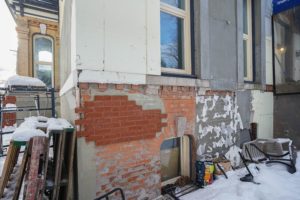The cautionary tale of 460 Wilbrod Street
François Bregha
Located at the south end of Cobourg Street, 460 Wilbrod is a large Victorian house. It is an individually designated building under Part IV of the Ontario Heritage Act and is part of the Wilbrod/Laurier Heritage Conservation District (HCD). The Wilbrod/Laurier HCD was created to protect an excellent example of a late 19th-century upper-middle-class residential neighbourhood which also happened to be home to four Canadian prime ministers.
One of the former residents of 460 Wilbrod was J. Mortimer Courtney, deputy-minister of Finance for 28 years (1878-1906). In 1908, after he retired, Courtney chaired a royal commission on public service reform that recommended the introduction of competitive exams for new hires and laid the basis for the merit-based system we know today.

Photo Hilary Duff
Over the years, the exterior walls of 460 Wilbrod deteriorated as a result of the brick being painted, and later sandblasted to remove the paint. In the fall of 2018, the owner of the property began to cover the brick with stucco panels both to protect it and to provide added insulation. This work did not require a building permit but it did require a heritage permit, which the owner did not apply for. When the City became aware of this work, it issued a Property Standards Order to stop the renovation, and repair or restore the heritage attributes of the building.
In the spring/summer 2019, the owner retained a heritage engineer to analyze options that would meet the intent of the Wilbrod/Laurier HCD management plan. The option that was eventually chosen involves removing the stucco panels on the front façade and applying a thin brick veneer to replace the exposed brick face; on the sides and rear, an insulating layer of Styrofoam will be covered by the same thin brick, providing an overall uniform appearance.
According to a City staff report, the heritage engineer obtained matching brick samples and a tinted mortar sample to ensure their compatibility with the building and the HCD. The thin brick will match as closely as possible the original bricks in colour, bond pattern, mortar colour, and profile. The detailed brick elements such as the voussoirs, brick string course, sills and window surrounds will also be reinstated. The timeline for completion of this project remains uncertain.
So, one could say that all’s well that ends well but there is clearly a lesson to be learned here. Many property owners do not know what their obligations are when undertaking work on a building in a Heritage Conservation District. Across the street from 460 Wilbrod stands 231 Cobourg, the former Ugandan High Commission which, while not a protected building, was allowed to deteriorate to such an extent through lack of proper maintenance that it will be demolished. A Heritage Conservation District is only as relevant as the sum of its parts: if parts start to disappear, not only is the district’s integrity compromised but so is the very reason for its existence. The City must bear some responsibility for the continued lack of awareness of heritage protection requirements among property owners and contractors; our Councillor Mathieu Fleury has declared his intention to work with City staff this year to ensure that this situation is improved.

Photo Hilary Duff
